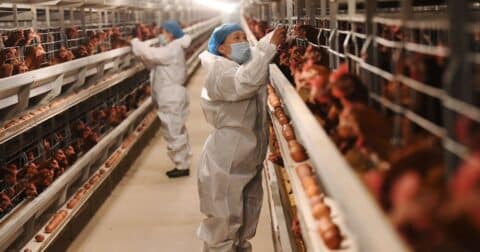Fact Check
Why Is There Soy in Practically Everything?
Diet•5 min read
Reported
In the U.S., bird flu is spreading rapidly on poultry and dairy farms—and data censorship could pose risks to combating it, experts say.


Words by Kiley Price
This article originally appeared on Inside Climate News, a nonprofit, non-partisan news organization that covers climate, energy and the environment. Sign up for their newsletter here.
There’s an epidemic raging in the avian world.
For years, the highly pathogenic H5N1 avian influenza has devastated global bird populations. In the United States, the disease has affected more than 136 million commercial, backyard and wild birds since January 2022. The virus has also jumped to other species—from elephant seals to cats.
It’s also found its way into humans. There have been dozens of cases in the U.S. including one death, though risk remains low, according to the Centers for Disease Control and Prevention (CDC). But several recent developments in the bird flu outbreak have given infectious disease experts cause for concern.
At the same time, the Trump administration has made major changes to data-sharing protocols at the CDC and withheld studies on bird flu in the past few weeks—moves that could disrupt efforts to contain the outbreak.
Bird Flu Updates: Last April, I wrote a newsletter about how H5N1 was spreading rapidly through the animal kingdom, how climate change is worsening the problem and why egg prices are so astronomical. Much of the piece still rings true, but there have been some crucial updates. Let’s dive in.
So far, more than 60 people in the United States have tested positive for bird flu since the current outbreak began. In January, the Louisiana Department of Health reported the first death from H5N1 in the U.S. Nearly all of the people infected by bird flu worked either on dairy or poultry farms, which have been forced to cull millions of birds to stem further infection, as my colleague Georgina Gustin reported in December.
For at least a year, bird flu has been infecting dairy cattle, which were not previously known to be susceptible to H5N1. Typically, the cows are infected by a variant of the bird flu virus known as B3.13. But last week, the United States Department of Agriculture announced a different bird flu strain known as D1.1—which was responsible for the Louisiana person’s death—spreading among cows for the first time in Nevada. On Monday, the CDC confirmed a dairy worker in Nevada was infected by the strain and while he has since recovered, scientists are concerned about this new development.
“The D1.1 has learned how to infect dairy cattle, and that’s a concern,” infectious disease researcher John Swartzberg told me. He’s a clinical professor emeritus at the University of California, Berkeley’s School of Public Health. ”It means that this virus continues to have tremendous alacrity in its ability to change and to change in a way that allows it to infect new hosts.”
Like many other disease experts, Swartzberg stressed that there is not yet cause for panic over bird flu sparking the next human pandemic. The highly pathogenic H5N1 was first detected in 1996 and has never caused a sustained, widespread outbreak in people. But in the past two years, H5N1 has proven to be an adaptable and, at times, unpredictable foe within the animal kingdom, so things could be different this time, Swartzberg said.
“We hadn’t seen H5N1 to any degree at all here in North America until it really has exploded over the last couple of years, first in a variety of different mammals and other birds, and now in cattle, which we never saw before. So something has changed,” Swartzberg said. “Does this something that’s changed mean that we’re on the verge of the virus figuring out how to infect and then transmit person to person? Nobody knows the answer to that.”
But there is a factor that could make it more difficult to find out.
CDC Scramble: At the end of January, several studies about bird flu were set to appear in the official journal of the CDC, known as the Morbidity and Mortality Weekly Report. This report is “the agency’s primary vehicle for scientific publication of timely, reliable, authoritative, accurate, objective, and useful public health information and recommendations,” according to the CDC website.
But on President Donald Trump’s first full day in office, Acting Secretary of the Department of Health and Human Services Dorothy Fink issued a memo putting an “immediate pause” on regulations, guidance, announcements, press releases, social media posts and website posts until such communications had been approved by a political appointee. The Morbidity and Mortality Weekly Report—which has been regularly published every week since the first installment decades ago—was caught up in the pause, sparking backlash from health officials across the country.
“It’s startling,” Tom Frieden, a former CDC director and the CEO of the nonprofit Resolve to Save Lives, told KFF Health News. He added that if the reports aren’t issued, “it would be the equivalent of finding out that your local fire department has been told not to sound any fire alarms.”
CDC spokesperson Melissa Dibble told KFF in January that “this is a short pause to allow the new team to set up a process for review and prioritization.”
The report resumed its publication last week—but there was an unusual hiccup, The New York Times reports. An initial online edition of the CDC report included a table of data regarding potential spread of bird flu between humans and cats. That table was the only mention of bird flu in the report, which was mostly focused on the health impacts of the Los Angeles County wildfires. However, the table quickly disappeared from the page, and is no longer included in the versions currently available online.
The CDC did not respond to a request for immediate comment on why the data was included then removed. Many health officials have expressed concern over potential federal censorship around bird flu and other crucial health data.
“We only know in retrospect when we hit the right amount of panic on this or not, but I think we can say with assurance that … without adequate data [and] without reliable data, then what that leaves is a vacuum,” Swartzberg said. “That vacuum is filled with speculation, and that leads to a tremendous amount of harm.”
The Biden administration faced criticism for its response to bird flu, which some research groups said fell short of the urgency and speed necessary to squash the spread. However, the former administration took a few key steps to prepare for more potential outbreaks of bird flu in people, including stockpiling vaccines and funding efforts to develop a new H5N1 avian flu mRNA vaccine that matches the strains circulating in cows and birds.
Meanwhile, some of Trump’s choices for key health leadership roles have expressed skepticism and platformed conspiracy theories about vaccines, The Atlantic reports. Robert F. Kennedy Jr.—Trump’s choice to lead the Department of Health and Human Services—claimed on X last year that there is “no evidence these [bird flu] vaccines will work” and that they “appear to be dangerous,” referring to the national stockpile. In a separate post, he implied that “someone might deliberately release a bioengineered bird flu.”
At the end of the day, it’s up to state health departments to decide how to respond to bird flu in people. But state responses vary, and federal health and tracking data is crucial for informing these decisions, experts say. Individuals can also take steps to reduce bird flu risks such as keeping cats inside to prevent exposure with wild birds and reducing contact with farm animals.